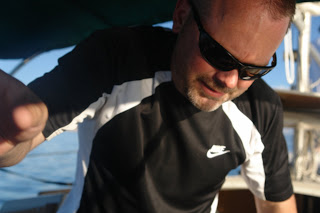 As the afternoon sun increased, so did the wind.
As the afternoon sun increased, so did the wind.
Up near Carrington Island in the Great Salt Lake, the winds heeled our Catalina 25, the Unsinkable 2, along at almost 7 mph. I remember first learning that most monohull cruising sailboats had theoretical maximum hull speeds somewhere between 5 and 8 miles an hour and thinking, “Wow, that is ridiculously slow.” But anyone who has ever been on a sailboat traveling at this speed knows that the feeling is quite remarkable, and feels very fast. (Remember, if you are in a hurry to get some place, stop reading this and choose something besides a sailboat.)
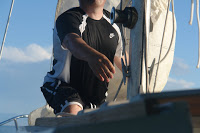
When you feel a 10 – 15 mile per hour wind fill a 25 foot high sail above you, and the boat responds by heeling over 20 degrees, you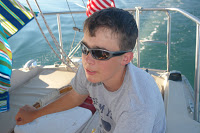 suddenly feel like you are in the America’s Cup. The adrenaline begins pouring through your body and every daily care is driven from your mind as your head fills completely with thoughts about every wave, wind, halyard, sail, and line on your boat. When you finish, you feel like you just finished a 3 day weekend vacation. Your mind is completely relaxed, and you are ready to take on life’s problems all over again.
suddenly feel like you are in the America’s Cup. The adrenaline begins pouring through your body and every daily care is driven from your mind as your head fills completely with thoughts about every wave, wind, halyard, sail, and line on your boat. When you finish, you feel like you just finished a 3 day weekend vacation. Your mind is completely relaxed, and you are ready to take on life’s problems all over again.
To put more power in the sails, we sat on the windward (high) side of the boat, hanging our feet over the side watching the miles of water slip by 6 feet beneath our feet. As the bow crashed through the waves, the spray covered us in refreshingly cool showers.
The crew was getting hungry, so I went below to cook lunch. I found the alcohol stove completely dry, and could not find more fuel anywhere. 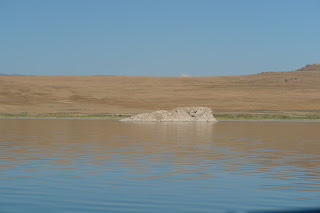 Without lunch, we were all getting a little tired, so we decided to head in to White Rock Bay on Antelope Island. We had a raft, and could go ashore and walk up to the gift shop at the state park to try and find some food.
Without lunch, we were all getting a little tired, so we decided to head in to White Rock Bay on Antelope Island. We had a raft, and could go ashore and walk up to the gift shop at the state park to try and find some food.
With the depth sounder on, we cautiously approached White Rock Bay. The water here was shallow, and we had to raise the swing keel and drop the sails as we slowly motored in to the anchorage, a few hundred yards west of White Rock. (See the picture, this rock extends about 15 feet out of the water, and is home to hundreds of birds.)
My #2 son began blowing up the raft, only to find that we didn’t have the valve cover for it! Swimming to shore was not an option, because the low water meant we would have to wade – not possible in the mud along the lake bottom. We had lots of freeze dried food (Mountain House is our preferred brand), but no stove to boil water. And then we noticed the solar showers on the deck. They were already at 110 degrees. So we poured water from the solar showers into the food, and waited 15 minutes for it to rehydrate. It was great!
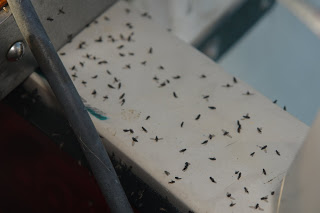
In the bay, we were gradually overcome by Brine Flies. At first there were hundreds of them, and then thousands. #2 started the fight against the Brine Flies, first with bug spray, then with a citronella candle, and finally gave up and took to photographing them. He has a very science-oriented mind, and when we finally returned home researched all kinds of information on Brine Flies. Here are some of the pictures he took of the Brine Flies and dragon flies.
What he learned was that Brine Fly season is between late July and early August. The flies lay eggs on the surf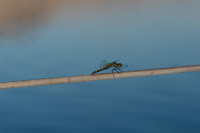 ace of the water, and then live 3-5 days.
ace of the water, and then live 3-5 days.
The flies do not bite or sting, they simply land on everything and crawl everywhere. We soon realized that overnighting anywhere near the Brine Flies would result in no one sleeping. For the first 10 minutes you try and brush the flies away, but then you tire, and just let them crawl all over you. Psychol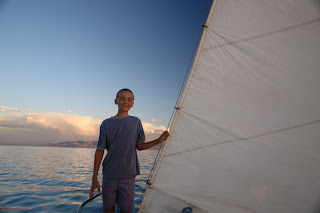 ogically, it must be like chinese water torture. One night under Brine Fly interrogation and I would have divulged every top secret I knew.
ogically, it must be like chinese water torture. One night under Brine Fly interrogation and I would have divulged every top secret I knew.
It was now 6pm, and time to discuss options. The Freshwater springs off the shore of Fremont Island were 10 miles to the north. Winds were still out of the north, and the sun would be setting sometime around 9 pm. Under motor, we could reach the springs in 2 hours. Sailing, though normally much faster than motoring, would take longer because we needed to go directly into the wind – a point which we could not sail without tacking.
So we decided to motor north, arrive at 8pm, swim for half an hour, and then raise sails and head for the Antelope Island Marina for the night. It was a great plan, and we were all really proud of how nautical it sounded.
However as we motored north out of White Rock Bay, I remembered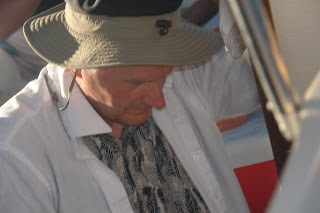 the chart showing shallow waters west of Antelope island, so we cut a wide circle around the tip of the island. And then I felt something bump the rudder. And again. Looking at the depth guage, I realized we were in extremely shallow waters. So we immediately cut further west for another mile and a half, still running into shallow water at every attempt to turn north.
the chart showing shallow waters west of Antelope island, so we cut a wide circle around the tip of the island. And then I felt something bump the rudder. And again. Looking at the depth guage, I realized we were in extremely shallow waters. So we immediately cut further west for another mile and a half, still running into shallow water at every attempt to turn north.
It was now 6:30 pm, and I thought about the harbor master’s comments that Fremont had claimed more sailboats than any other island on Great Salt Lake. I also remembered what he said in an email about our planned trip,
“My experience has shown that the first time a sailor ventures out on his first long voyage on the Great Salt Lake, she will let you know who is boss and will likely challenge you with blustery winds, challenging seas, and a little lightning for emphasis. If you survive these conditions, return home safely to challenge her again with respect, she will usually treat you kindly and provide an enjoyable experience (as long as you really check your weather charts thoroughly this time.)”
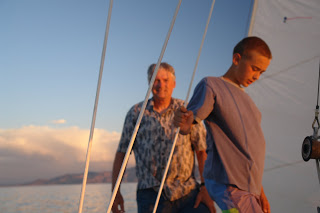
So we had a decision to make – if everything went well, we could make Fremont Island, and then find the Marina in the dark. But if anything went wrong, we’d spend the night out in unsheltered water. No one wanted to quit, but we decided that was the best choice.
So we turned south, and raised sails to cover the 20 miles back to the South Shore Marina.
